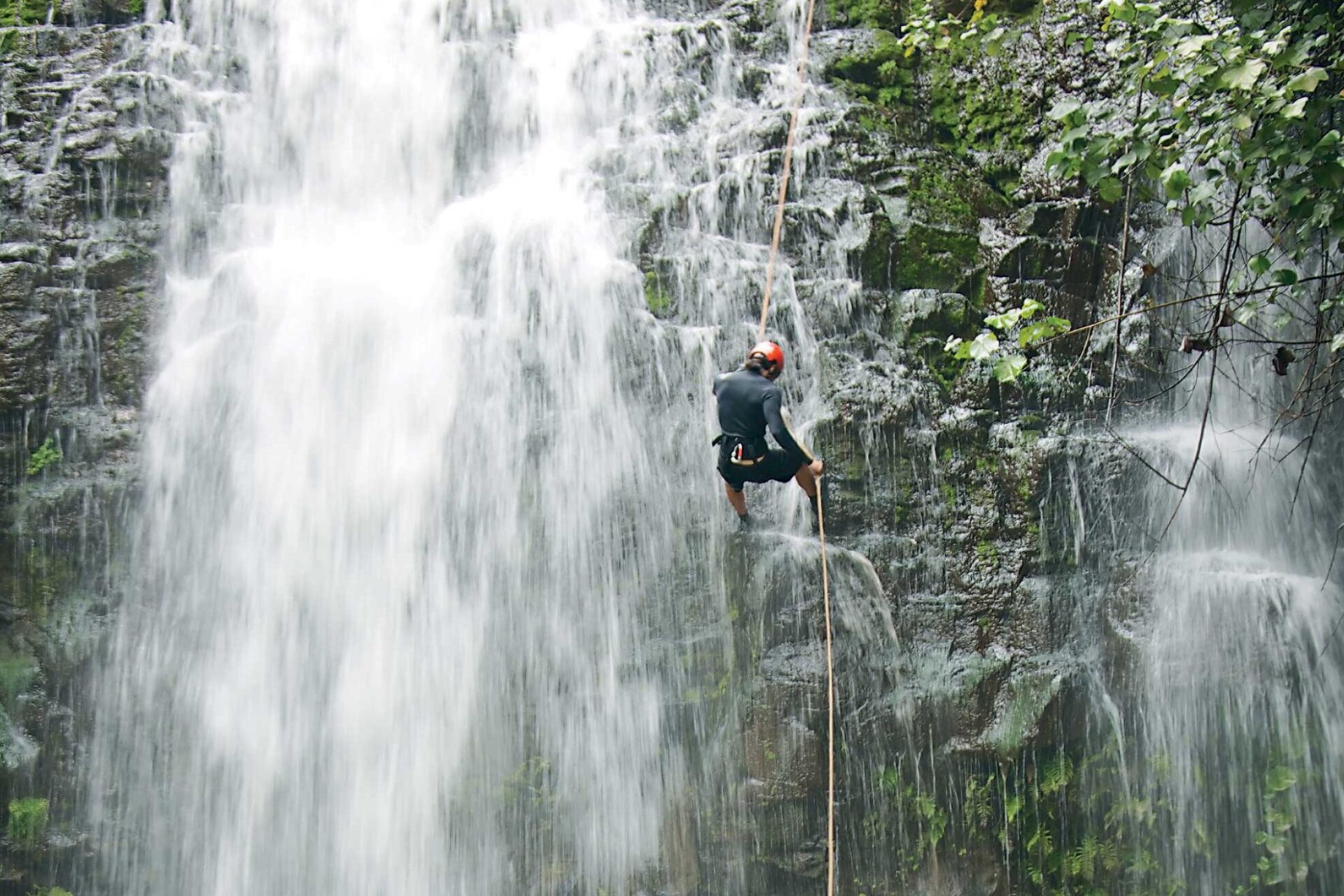Don’t take this the wrong way, but hiking in Hawai’i will kick your butt. We believe you, that your past, outdoor-adventuring accomplishments are impressive and were no cake walk. We have cake-walk types of hikes here, too. It’s just the hard ones tend to be very strenuous and not just due to length or elevation gains (though those definitely factor in). It is the other elements of the outdoor equation that can make hiking so difficult and, at times, hazardous. Here we would like to discuss the terrain, conditions and situations that can make otherwise beautiful hikes feel like the Bataan Death March, as well as some tips to be well prepared for your slog through paradise.

A hiker stands at the end of a trail enjoying the fruits of her labors. Being prepared can help you reach the goal.
The Hawaiian Islands are volcanoes. Volcanoes that have had millions (at least in most cases) of years of erosion to etch the gravity defying cliffs and deep, jungle valleys that hold some of the most fantastic hiking trails. This has made for some very steep hillsides that might seem climbable when going downhill but then become impossible to climb back out of. This is why staying on trails is a good thing. Though staying calm is one of the most important things you can do if you become lost, keeping that calm gets pretty hard if you end up having to stay overnight, unprepared, in the bush. As small as an island like Kaua’i might seem, that civilization is never all that far away, there are many places where a bit of off trail exploring can land you in a situation where you can’t get back out. This is especially true if you become injured in the process. In a cases like that, helicopter rescue is often the only option (every year is happens across the state to visitors and residents alike). We don’t want to be buzzkills when it comes to this stuff. We really do advocate going out and experiencing what this incredible state has to offer. We also spend a lot of time trying to find new and exciting places to go and for every hike we share, there are many others where we had to use better judgement and turn around when things got too sketchy.
Another factor that can take you out of your comfort zone is the weather. As lovely as the weather is most of the time here, the same natural forces that shaped those wondrous valleys are still at work. Rain is a certainty in many areas. Even if you’re on the dry, leeward side of the island, a rainstorm in the mountains can send a gulley-washing flood your way when there’s not a cloud anywhere around you. If you’re hiking areas prone to a lot of rainfall, (newsflash) you’re going to get wet. And stay wet. One of our field researchers, during an overnight hiking expedition, didn’t quite grasp how complete the soaking would be. It is one thing to hike over steep, uneven terrain and gain over 1,000 feet in elevation. It is another to do so after having been wet from head to foot (the feet bearing the worst of it) for 36 hours straight in mud-caked, waterlogged boots and clothes (plus a pack). Then you have to go back downhill, too. If you’ve never had to hike downhill for miles, know that the action stresses not just your knees, but your toes too. Do it while digits are like prunes and you’re bound to lose a nail or two. You’ll never take dry socks for granted again. So, how do make some of the more intense hiking adventures less extreme? Planning, knowing the weather forecast, and luck. As they say, luck favors the prepared, so here are some things you should consider before embarking on that hike into the unknown.
Rappel

Da Life Outdoors – Waterfall Rappel
In Hawai‘i, ziplining is popular, but for a real adrenaline rush, try rappelling with Da Life Outdoors in Lihu‘e. You’ll rappel down two waterfalls: a 30-footer and a 60-footer that combines walking and sliding. The 4-hour adventure includes hiking, swimming, and lunch.- Know the weather forecast. We just said that above, but it is really important. We are NOAA junkies here at Hawai’i Revealed and check for updates every morning and throughout the day. Local newspapers and news channels (especially their websites) should also be checked for more specific reports and forecasts.
- Know where you’re going. Seems obvious, right? Know the name of the area you’re heading to. Know the road name. Know the trail name. Let someone who isn’t going know where you’ll be and how long you estimate it will take you to get back. Even if it is someone at the front desk of your hotel, it is important to let someone know where to look should you not return when estimated. We do our best when creating the maps for our guidebooks and apps (which are GPS aware), but they should not be used in lieu of responsible planning since books can be lost, electronics can get wet and batteries can die.
- Start early. Conditions across the state are almost always better in the mornings. Also, the more daylight you have, the more time you have to explore and take in everything around you.
- Pack rain gear and some extra clothes. Even though it was a sweltering 85 degrees at the beach the morning you left for your hike, it could be (a probably is) windy and rainy somewhere along your route. And you just had to wear that new tank-top and cutoffs. Even if conditions aren’t hypothermia-inducing, it is best to have rain gear with you. You don’t want to be overburdened with too much stuff in your pack (you are bringing a backpack, right?), but this stuff falls into the category of better to have than not when the need arises.
- Have hiking shoes/boots. Sturdy footwear is a must for virtually every hike we describe in our guidebooks. Muddy trails, rocks and tree roots abound on many hikes, all of which can lead to a twisted ankle or worse. More specialized footwear like tabis are also nice to have if you’re crossing any streams where slippery rocks and boulders are an issue.
- Drink plenty of water. We can’t stress this enough. Being hydrated is vital to staying alert. Thirst, fatigue and stress are not going to help you in making sound decisions when it counts. Consider a hydration pack that fits in your backpack. We also like to bring some kind of water filtration with us, just in case (should filter at least to 0.2 microns, best to also use a chemical treatment or boil, if possible). A snack with lots of protein is also a good addition.
- Use your judgment. There is nothing that can replace your own common sense. If you’re doing one of the activities you read about in our book or someplace else and your instinct tells you something is wrong, trust your judgment and go do another activity. There are plenty of wonderful things to do on the island, and we want to keep you safe and happy.
This is by no means a comprehensive list. There are numerous items that we didn’t mention (sunscreen, hat, etc.) that should already be a part of your “going out into wild Hawai’i” kit. Though we focused mainly on the wetter environments you may encounter here, the above list is just as important when hiking barren lava fields, coastal trails or volcano craters. Hiking in Hawai’i can give you a better glimpse into just how unique and beautiful these islands are. Don’t underestimate how steep, slippery and sharp things can be on the trails, though.

Andrew Doughty is the famous author of the widely popular Hawaii Revealed series including Kauai Revealed, Oahu Revealed, Maui Revealed and the Big Island Revealed. He moved to Kauai many years ago after he fell in love with the beauty of the islands and decided to never go back. He is known for his candid opinion on each of Hawaii’s attractions, be it a restaurant, a helicopter ride, a beach or a resort. For the last two decades, he has managed to keep his identity anonymous so that his reviews can remain unbiased and only be influenced by his own opinions and thoughts. You can learn more about his beautiful journey at this link – About the author






0 Comments